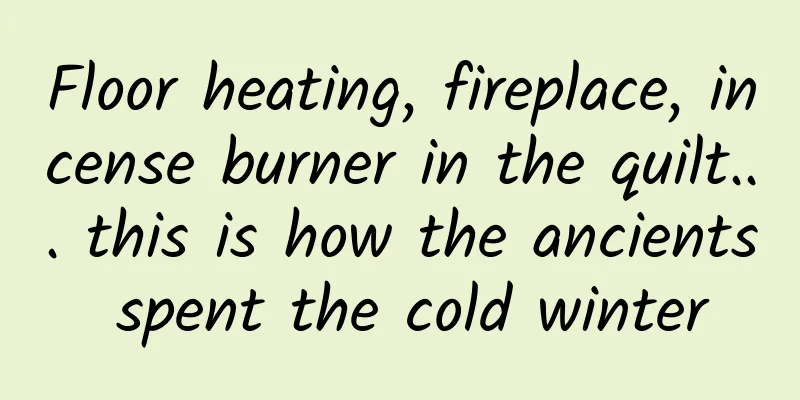Floor heating, fireplace, incense burner in the quilt... this is how the ancients spent the cold winter

|
Faced with the bitter cold winter, as people living in the 21st century, of course we choose to turn on the air conditioner, turn on the heater, and then hide in the warm bed to enjoy the comfort brought by the high temperature. Fire pit Excavations at sites such as Banpo and Jiangzhai show that the ancestors of the Jiangzhai site of the Yangshao culture 4,600 years ago moved the fire inside the house. A shallow pit was dug in the main room, called a fire pit, where firewood or charcoal was placed to burn. This cooking and heating facility can absorb oxygen from the outside to help combustion, and can also block the cold wind blowing in from the door in winter. Kang and "floor heating" As early as the Wei and Jin Dynasties, there were records of people using "kangs for heating" in Northeast China. This is a common bed type in the north, that is, a bed made of adobe or bricks with a hole underneath for making fire for heating. In the imperial palace of the Qing Dynasty, all the rooms of the emperor and empress, palace maids and eunuchs had kangs. After the Qing Dynasty established its capital in Beijing, it developed the "heating on a kang" between the white mountains and black waters into the "heating on a fire floor" in the Forbidden City. Craftsmen laid underground fire channels under the palace and covered them with square bricks. Then, in a hidden place outside the living room, they set up outlets for adding fuel and cleaning ashes, as well as ventilators for drawing wind and assisting combustion. Finally, they burned charcoal in a pit (i.e., the stove mouth) more than one person deep outside the palace. The fire heated the square brick floor, which not only had a large heat dissipation area and uniform heat, but also diffused the heat in the inner room to achieve the function of floor heating, and there was no soot and dust pollution. However, the fire cellar under the square brick floor burned only high-quality charcoal, which consumed a lot of money for a whole winter and was not affordable for ordinary people. Fireplaces and Fire Walls Can you believe that fireplaces already existed in the Qin Dynasty? According to the "Qin Palace Culture", archaeologists found three fireplaces next to the bathing pool at the Xianyang Palace site, which seemed to be equipment for heating. Researchers believe that this should be a relatively advanced method under the conditions at that time. Fireplace heating can overcome the disadvantages of heating with a fire pit. Greenhouse and pepper house There was a palace called Greenhouse Palace in the Han Dynasty. Jin Zhuo's annotation in "Book of Han·Biography of Kong Guang" reads: "There is a Greenhouse Palace in Changle Palace." The Greenhouse Palace was a warm palace where the emperor lived in winter, and there were various special equipments in the palace to prevent cold and keep warm. In the Han Dynasty, there was also a greenhouse for growing vegetables. At that time, there was a kind of leek called Wenjiu, which was one of the main vegetables. The so-called Wenjiu refers to leek grown with greenhouse technology. In the Han Dynasty, Chang'an had a vegetable greenhouse specifically for the palace. "The Imperial Garden planted winter onions and leeks, covered them with roofs, and burned fires day and night to wait for the warm air to grow." In ancient times, pepper was also the main item for winter heating. "Xijing Miscellaneous Records" records that the walls of the greenhouse hall were painted with pepper and mud, and the walls were covered with brocade mainly with cinnamon. There was a Huoqi (mica) screen, a Hongyu tent, and a Western carpet on the ground. In the Han Dynasty, there was a palace called the Pepper Room Hall. Li Shan quoted the "Sanfu Huangtu" and noted: "There is a Pepper Room Hall in the Changle Palace." This hall was the queen's room during the reign of Emperor Gao. There is another one in the Weiyang Palace, located to the north of the front hall. Since the Pepper Room Hall was the palace where the queen lived, "Pepper Room" became a synonym for the queen. This heating method and habit continued until the Sui and Tang Dynasties. Incense burner in the quilt There is also a kind of silver sachet which was a rare item that only nobles could use in the Tang Dynasty. It has a special name, "Bei Zhong Xiang Lu". The spherical structure of the Beizhong Incense Burner is very delicate. The outside is wrapped in copper hollow metal, and the inside is composed of several metal rings with mutually perpendicular axis lines. There is an incense bowl for placing spices at the central axis. If you want to prevent an object of a certain weight from tilting and falling over, the best way is to use the fulcrum suspension method. The Beizhong Incense Burner uses this method, hanging the incense bowl in an inner leveling ring with an axis hole on each side. When the inner leveling ring is in a horizontal position, the incense bowl will not tilt left and right due to its own weight. In addition, the braziers and hand warmers that are often seen in movies and TV dramas are also the main tools used for heating in ancient my country... These crystallizations of the wisdom of the ancients may have been passed down for thousands of years to the present, or may have disappeared in the long river of history, but the cultural treasures left to future generations all speak of their infinite wisdom and creativity. This article comes from: China Digital Science and Technology Museum |
<<: Your child has trouble concentrating? See how the Mengzi family handles it...
>>: Why don’t these animals feel thirsty when hibernating?
Recommend
The content community operation logic of Xiaohongshu!
In 2012, cross-border e-commerce was in its infan...
I get scared as soon as I enter the elevator. Is this also a psychological problem?!
Review expert: Li Xianhong, national second-level...
Sony's new flagship Z4 is released: These points are disappointing
Sony has finally officially released its new gene...
How to give a mini program a “good name”?
Q: How to give a mini program a “good name”? A: N...
How to quickly find eight golden rules for APP operation and promotion shortcuts! !
The eight golden rules introduced in this article...
Kuaishou operation and promotion: How to continue to make efforts to create hot products?
It is not easy to stand out among the 15 million ...
How to save bidding promotion costs? How to adjust the bidding promotion cost if it is too high?
In the past, I was mainly responsible for optimiz...
Kuaishou director teaches: Playing short videos, ordinary people can also earn more than 10,000 yuan a month
"Ordinary people can also earn over 10,000 y...
Are black takeaway spoons poisonous? Do you still dare to use them?
Editor: Gong Zixin When you order takeout, do you...
Musk did not brag and published a statement announcing the source of funds for privatization
On August 13th local time, Musk announced some de...
Aristotle, a man often "overthrown" in textbooks
I wonder if you have noticed such a man in your s...
How to increase followers of a public account? Master these 6 points!
The WeChat public account has been open for a lon...
Tencent Advertising advertiser account opening qualification requirements!
Enterprise account opening qualification requirem...
How can 5G mobile networks unlock advanced digital transformation?
5G connectivity is critical to facilitating the o...
Robin Li: The mass-produced car will be launched in July next year without a steering wheel and driver's seat
On December 3, the 4th World Internet Conference ...









